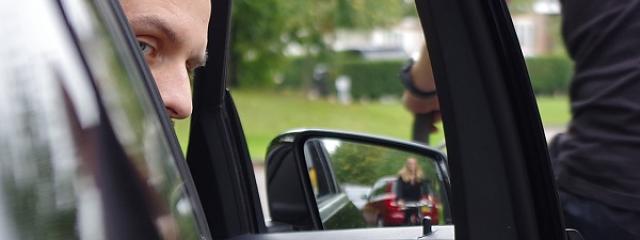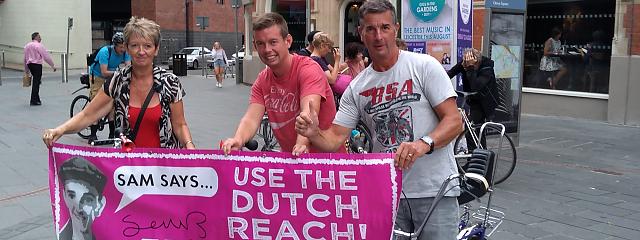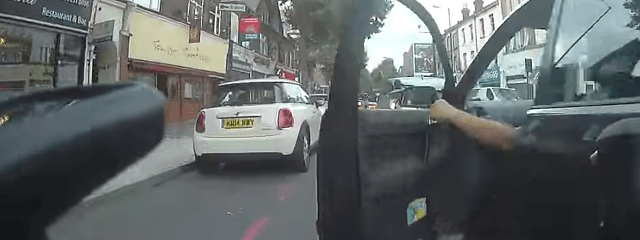
Our Dutch Reach campaign: 15 FAQs
Our Dutch Reach campaign: 15 FAQs
1. What is this campaign about?
This campaign aims to highlight the risk of opening a car door without looking behind first, and how this can be avoided through a simple technique known as the Dutch Reach.
2. What is car-dooring?
Opening a car door in front of an approaching cyclist or motorcyclist can knock them off their bike. They might not have the time to react and avoid the door. Car-dooring is the term often used to describe collisions like this, which can be fatal.
3. What is the Dutch Reach?
The Dutch Reach is a simple technique to ensure that drivers and passengers always look over their shoulder before opening their car door. Instead of opening your car door with the hand nearest the door (your right hand if you’re the driver in the UK), you use the hand furthest from the door. Doing this naturally turns your body, so you can look over your shoulder for people on bikes and other roads users.
4. How common is car-dooring?
In the five years to the end of 2017, the GB casualty statistics show that seven people died in car-dooring collisions. The statistics also reveal that each year over 60 cyclists suffered serious injuries and over 500 slight injuries. We know however that the actual number of injuries caused by car-dooring is much higher, because the casualty statistics only reflect those cases that are attended by the police, which often isn’t the case in minor injury cases.
5. Why are Cycling UK campaigning on this?
Car-dooring collisions are avoidable, if only people look before they open their door. We’re promoting the Dutch Reach to highlight this, and nudge people towards thinking about making a tiny change in their behaviour, which can then become a habit.
6. Wouldn’t better infrastructure stop car-dooring?
It’s vital that we get better infrastructure for cycling, which is why we’re currently campaigning alongside Living Streets for more money for walking and cycling in England, and we’ll carry on lobbying and campaigning for infrastructure investment across the UK. In the meantime, campaigning to promote the Dutch Reach means we can ask people to change one thing they do, today. Given that 40% of people indicated in a recent survey that they are put off cycling because of the fear of car-dooring, this is a simple behaviour change campaign which addresses one of the current barriers to getting more people riding bikes.
7. Shouldn’t we just be advising cyclists to ride further out from parked cars?
We do advise people to cycle at least a door’s width from parked cars, and recently produced a video about road positioning which included that advice. However, other vehicles, potholes and just other people’s behaviour means that it isn’t always possible to stay a car door’s width from every parked car. It’s also difficult to do so when filtering through traffic, and some collisions are caused when car doors are opened by passengers in stationary vehicles into the path of people riding in a cycle lane. So, though we’ll continue to give advice about road positioning and avoiding the door zone, it’s vital that we address the cause of car-dooring, which is people not looking before they open their car door.
8. Why can’t people just use their mirror to look behind?
Some of the fatalities and serious injuries through car-dooring, including the tragic death of Sam Boulton have involved rear seat passengers, who don’t have an option of using a side mirror. Using the Dutch Reach, whether you’re the driver or a passenger, just engrains a safe habit.
9. Who are we targeting with this campaign?
It’s not really Cycling UK's members, or even people who already ride bikes, most of whom should realise the dangers of opening a car door without looking. We need to change the behaviour of people when they're in their cars, both drivers and passengers, who just haven’t thought about those dangers. What we’re asking members and supporters to do is help us promote this campaign by sharing the films we have produced with friends and colleagues who don’t currently cycle.
10. What films and other materials have we produced?
Following the success of our Too Close for Comfort campaign, where we produced both virtual reality and 2D educational films to highlight the dangers of overtaking cyclists without leaving enough space, we’ve produced a number of educational films relating to the Dutch Reach. These are designed to be impactful, showing the consequences of opening your car door without looking, and demonstrating how to do the Dutch Reach to avoid this. We’ve also produced a written guide available in hard copy and online.
11. How can I view the VR film?
Follow the steps for watching our Too Close for Comfort film in VR, and it’s exactly the same for the Dutch Reach VR film.
12. How are we planning to use these materials?
We are making these materials freely available to driving instructors, driving schools, road safety organisations, road safety partnerships, police forces and to anyone who wishes to promote this. Ultimately, we want these materials to be part of a wider suite of materials which are available online to anyone learning to drive, promoted by the DVSA and driving instructors, and used in driver re-training and education.
13. How you can help?
If all of Cycling UK’s 66,000 members shared one of these films with eight friends or colleagues who don’t cycle, with your help we’d reach over half a million people. With 2.1 million people in Great Britain cycling at least three times a week, we could reach over 10 million people if they all shared this with five people. So, you can help by being a Dutch Reach Hero and sharing the films to #TeachTheReach and get everyone to #DoTheDutchReach.
14. Isn’t the Highway Code going to be amended to include reference to the Dutch Reach?
Last November, the Department for Transport published its recommendations following a walking and cycling safety review. In response to campaigning by Cycling UK these included a commitment to review the existing guidance in the Highway Code to improve safety for cyclists and pedestrians, with specific reference to car-dooring and the Dutch Reach. However, the formal consultation into changes to the Highway Code hasn’t commenced yet, and amending the Code, whilst important, is not enough. We need to increase public awareness as well.
15. Why have we partnered with Uber on this campaign?
The target audience for this campaign is car drivers and passengers, who don’t cycle. Uber can help us reach that audience through their communication channels, and they will be communicating via multiple channels to a different audience, which we would struggle to reach, including people using their app.














